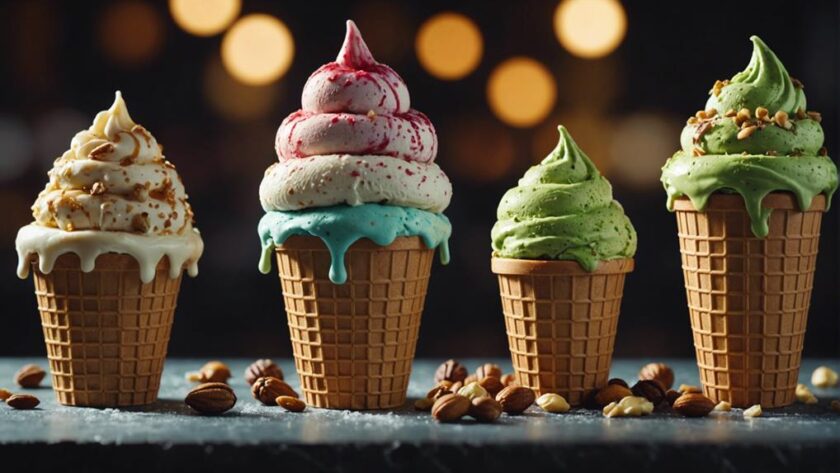Step into a world where ancient rulers mixed snow with honey and fruit juices, paving the way for the diverse frozen treats you love today. In Europe, gelato influenced the elite's love for ice cream, leading to the birth of ice cream shops. The Industrial Revolution then transformed ice cream production, making it more efficient and widespread. Fast forward to modern times, where liquid nitrogen creates creamy textures and unique flavors like charcoal and matcha tantalize taste buds. With ice cream being a global comfort food, the journey from ancient treats to modern marvels is a delicious exploration waiting for you.
Ancient Origins of Ice Cream
Ancient civilizations like the Chinese and Persian rulers crafted early versions of ice cream by blending snow with fruit juices and aromatic ingredients such as rose water and honey. The history of ice cream dates back to these innovative beginnings, paving the way for the diverse range of frozen treats enjoyed today.
While chocolate chip ice cream may seem like a modern delight, its roots can be traced back to the early experiments with frozen desserts. Imagine the decadent combination of creamy ice cream infused with rich chocolate chips, a treat fit for royalty even in ancient times. As civilizations evolved and traded flavors and techniques, the concept of adding chocolate chips to ice cream became more refined, contributing to the delightful array of flavors we savor today.
Evolution of Ice Cream in Europe
During the 17th century, ice cream gained popularity among Europe's elite and royalty, marking the beginning of its evolution in the region. Italian ice cream, commonly known as gelato, played a significant role in shaping the development of ice cream in Europe.
In the 18th century, ice cream recipes started spreading across the continent, leading to the establishment of the first ice cream shops. Italian ice cream makers brought their expertise to countries like France, influencing the creation of French-style ice cream with its creamy and luxurious texture.
European countries with strong culinary traditions such as Italy and France have continued to influence the evolution of ice cream by introducing a wide variety of flavors and textures. The Industrial Revolution in Europe further revolutionized ice cream production by mechanizing the process, making this delectable treat more accessible to the general population.
The impact of Italian ice cream artisans and the rich culinary heritage of European nations have collectively contributed to the diverse and high-quality ice cream offerings available in the region today.
Impact of Industrial Revolution on Ice Cream

The Industrial Revolution revolutionized ice cream production through the invention of efficient ice cream machines. This period marked a significant shift in the way ice cream was made, with the introduction of machinery that could churn out larger quantities in a shorter time. As a result, ice cream became more accessible to the general population, no longer reserved for the elite.
Advancements in refrigeration technology also played a pivotal role, ensuring that ice cream could be stored and transported efficiently.
Moreover, the Industrial Revolution facilitated the availability of key ingredients like sugar and vanilla, thanks to improved trade routes and production methods. This led to a surge in the popularity of ice cream as these flavors became more widely incorporated into recipes. Ice cream parlors and soda fountains began to emerge, providing social spaces where people could gather and enjoy their favorite frozen treats.
Modern Innovations in Ice Cream
In the world of ice cream today, numerous cutting-edge innovations have transformed traditional frozen treats into culinary marvels. When making ice cream, there's a growing need to make use of liquid nitrogen. This technique allows for the creation of ultra-smooth and creamy textures that elevate the overall experience.
Additionally, innovative flavors such as charcoal, matcha, and lavender have gained significant popularity, offering unique taste profiles for adventurous consumers. For those with dietary restrictions, the industry has introduced non-dairy alternatives like coconut milk and almond milk to cater to vegan and lactose-intolerant individuals.
Another trendy option is customizable ice cream rolls, made on a frozen plate, providing a fun and interactive dessert experience. Furthermore, molecular gastronomy techniques like spherification and foams are being incorporated to create one-of-a-kind ice cream experiences that push the boundaries of traditional expectations.
These modern innovations continue to shape the evolution of ice cream, offering a diverse range of options for enthusiasts worldwide.
Global Influence of Ice Cream

With its ubiquity across cultures and age groups, ice cream's global influence is unmistakable, shaping dessert preferences worldwide. From the bustling streets of Tokyo, where matcha-flavored soft serves are a popular treat, to the gelaterias in Italy serving up creamy scoops of stracciatella, ice cream has made its mark on every corner of the globe. In the United States alone, the average person consumes a staggering 23.2 quarts of ice cream annually, showcasing the widespread love for this frozen delight.
The global impact of ice cream extends beyond consumption figures. It serves as a universal comfort food, bridging cultural divides and bringing joy to people of all backgrounds. Whether it's the rich and decadent premium varieties with a minimum of 10% butterfat or the exotic flavors like durian in Southeast Asia, ice cream continues to evolve and adapt to local tastes worldwide. The sheer volume of over 4 billion gallons consumed annually speaks volumes about the worldwide appeal and influence of this beloved dessert.
Conclusion
As you lick your modern ice cream cone, remember the ancient origins and innovative evolution of this sweet treat. From humble beginnings to global popularity, ice cream has come a long way.
Who'd have thought that a simple frozen dessert could spark such creativity and delight? So next time you indulge in a scoop or two, savor the irony that something so simple could bring so much joy and innovation to the world.





